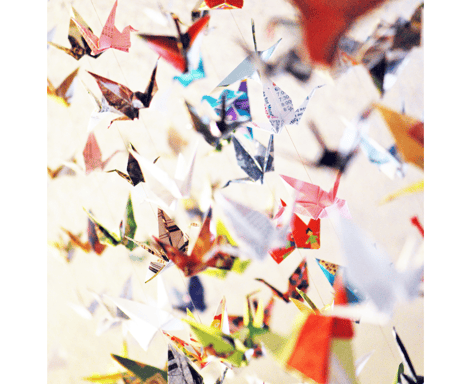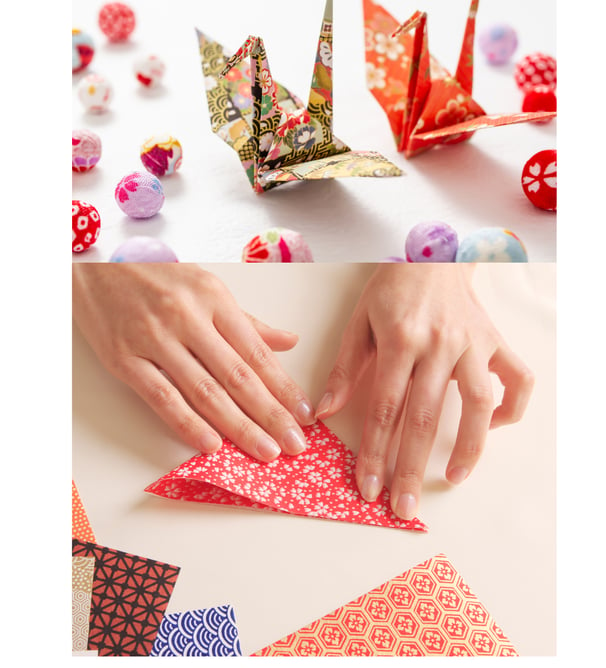Origami
Unfolding the Art of Paper Folding
Origami is a captivating and creative art form that transforms a simple sheet of paper into intricate and beautiful three-dimensional sculptures. As a beginner, you're about to embark on a journey of folding, shaping, and crafting stunning paper creations. In this introduction to origami, we'll explore the basics of this ancient Japanese craft, from essential tools to simple folds that will help you get started on your origami adventure.
Essential Origami Tools: Origami requires minimal tools, making it an accessible and enjoyable hobby:
Origami Paper: Choose square sheets of origami paper in various colors and sizes. You can find pre-cut origami paper or cut your own from regular paper.
Folding Guide: Utilize diagrams or instructional videos to guide you through each fold.
Clean Workspace: Create a clutter-free workspace with ample room to fold and create.
Basic Origami Folds: Start your origami journey by mastering these fundamental folds:
Valley Fold: Fold the paper towards you along the dashed line, creating a "V" shape.
Mountain Fold: Fold the paper away from you along the dashed line, forming a mountain-like shape.
Squash Fold: Flatten a folded section of paper by pushing the sides inward.
Reverse Fold: Fold a flap of paper in the opposite direction to create a new layer.
Getting Started with Origami: Follow these steps to create a simple origami project:
1. Choose a Design: Select a beginner-friendly design, such as an origami crane or a simple box.
2. Prepare Your Paper: Use a square sheet of origami paper and follow any size specifications mentioned in the instructions.
3. Follow the Diagrams: Carefully follow the folding diagrams or instructions step by step.
4. Practice Patience: Take your time with each fold, ensuring accuracy and neatness.
5. Enjoy the Process: Embrace the meditative and creative aspects of origami as you fold your paper into a work of art.
Exploring Origami Variations: Origami offers endless possibilities for creating diverse and unique paper sculptures:
Modular Origami: Create intricate designs by folding and interlocking multiple units.
Wet-Folding: Dampen the paper to make it more pliable, allowing for more organic and sculptural forms.
Kirigami: Combine origami with paper cutting to create delicate and detailed designs.
Tips for Success:
Start with simple designs and gradually progress to more complex projects.
Use origami paper for crisp folds, as it's specifically designed for this craft.
Practice each fold multiple times to build muscle memory and precision.
Origami is a delightful and rewarding hobby that allows you to transform paper into captivating works of art. With practice and patience, you'll master the art of paper folding and create stunning origami creations that showcase your creative talents. Happy Crafting!


Creating Animals and Creatures
Origami has the remarkable ability to bring paper to life, transforming it into adorable animals and creatures that capture the imagination. As a beginner origami enthusiast, you have the opportunity to explore the enchanting world of folded paper animals and creatures. In this guide, we'll delve into the art of creating origami animals, from charming cranes to whimsical frogs, and guide you through the steps to bring these creatures to life.
Origami Animal Basics: Before you dive into creating origami animals, familiarize yourself with a few key concepts:
Base Folds: Many origami animals start with common base folds, such as the bird base or frog base, which serve as a foundation for shaping different parts of the animal.
Symmetry: Pay attention to symmetry and alignment to ensure your origami animals look balanced and proportional.
Origami Animal Projects: Let's explore some beginner-friendly origami animal projects:
Origami Crane: Create the iconic origami crane, symbolizing peace and longevity. This project involves several folds to shape the wings, body, and tail of the crane.
Origami Frog: Craft a delightful origami frog that can "jump" when you press its back legs. This project introduces you to the concept of pleats and reverse folds.
Origami Fish: Dive into the world of underwater creatures by folding a charming origami fish. This project involves a combination of valley and mountain folds.
Origami Cat: Fold an adorable origami cat that stands upright. This project introduces the concept of inside reverse folds to create the head and tail.
Origami Dog: Craft a cute origami dog that can sit up. This project incorporates petal folds and inside reverse folds to shape the ears and tail.
Personalizing Your Origami Animals: Once you've mastered the basic origami animal designs, feel free to add your personal touch:
Expression: Adjust the placement of eyes, ears, or other features to give your animals unique expressions.
Colorful Paper: Use origami paper in various colors to create vibrant and eye-catching animals.
Scale: Experiment with different paper sizes to create larger or smaller animals.
Tips for Success:
Follow instructions and diagrams carefully, especially when shaping intricate details.
Practice each fold multiple times on scrap paper before using your preferred paper.
Be patient and don't be discouraged by initial challenges—it's all part of the learning process.
Creating origami animals is a delightful and charming way to explore the world of paper folding. With practice and creativity, you'll soon be crafting an array of adorable creatures that showcase your growing origami skills. Happy Crafting!


Exploring Advanced Techniques
Origami is an art form that continuously evolves, offering endless opportunities for creativity and innovation. As you gain confidence and experience in origami, you'll find joy in exploring more advanced techniques that go beyond traditional folds. In this guide, we'll dive into advanced origami techniques, including shaping, wet folding, and tessellations, allowing you to push the boundaries of paper folding and create intricate and mesmerizing designs.
Shaping and Sculpting: Advanced origami often involves shaping and sculpting paper to create intricate details and realistic forms:
Sculpting Details: Use your fingers to shape and curve paper layers to add depth and dimension.
Crimping: Create accordion-like folds to add texture and detail to your origami creations.
Curling: Gently curl paper edges to create rounded shapes and delicate contours.
Wet-Folding Technique: Wet folding is a technique that uses dampened paper to achieve more organic and flowing forms:
Dampening the Paper: Lightly moisten the paper with a damp sponge or cloth to make it more pliable.
Softening Edges: Use wet folding to soften edges and curves, allowing for smoother shaping.
Sculptural Effects: Wet folding allows for sculptural effects and natural-looking curves in your origami creations.
Tessellations: Tessellations involve repeating geometric patterns to create intricate and mesmerizing designs:
Pleat Folding: Create pleats and folds in a precise pattern to achieve tessellated designs.
Exploring Complexity: Start with simple tessellations and gradually progress to more complex and intricate patterns.
Precision: Precision and attention to detail are key when working on tessellation projects.
Combining Techniques: Experiment by combining different advanced techniques to create truly unique origami artworks:
Shaped Wet Folding: Use wet folding to shape and sculpt paper, enhancing the overall design of your origami creation.
Tessellation and Shaping: Incorporate tessellations and sculpting to add complexity and dimension to your folds.
Color Effects: Play with color changes and gradients to add visual interest to your advanced origami pieces.
Tips for Success:
Study advanced origami books and resources to learn new techniques and concepts.
Practice each technique on scrap paper before applying it to your main project.
Embrace experimentation and don't hesitate to push the boundaries of traditional folding.
By exploring advanced origami techniques, you'll not only enhance your paper folding skills but also unlock a world of artistic possibilities. As you experiment with shaping, wet folding, tessellations, and other techniques, you'll create origami artworks that captivate the eye and showcase your creativity and innovation. Happy Crafting!

